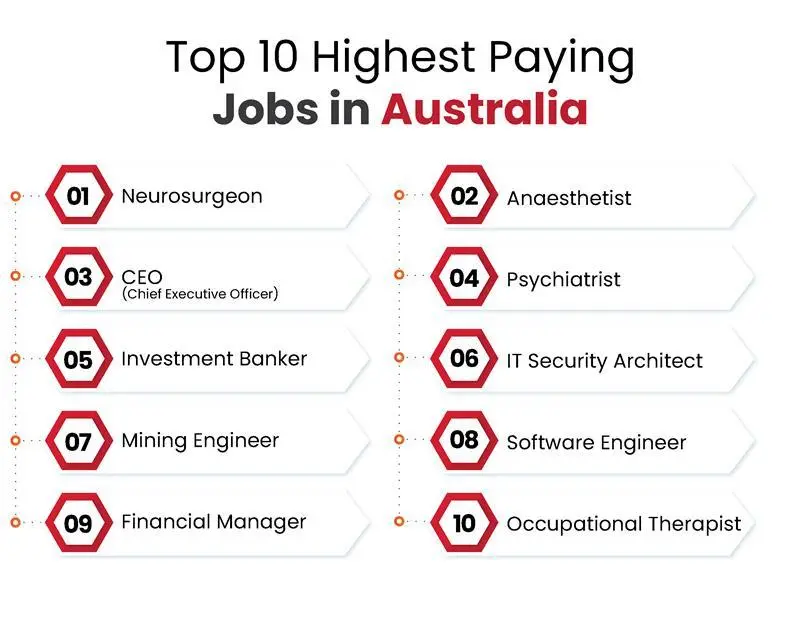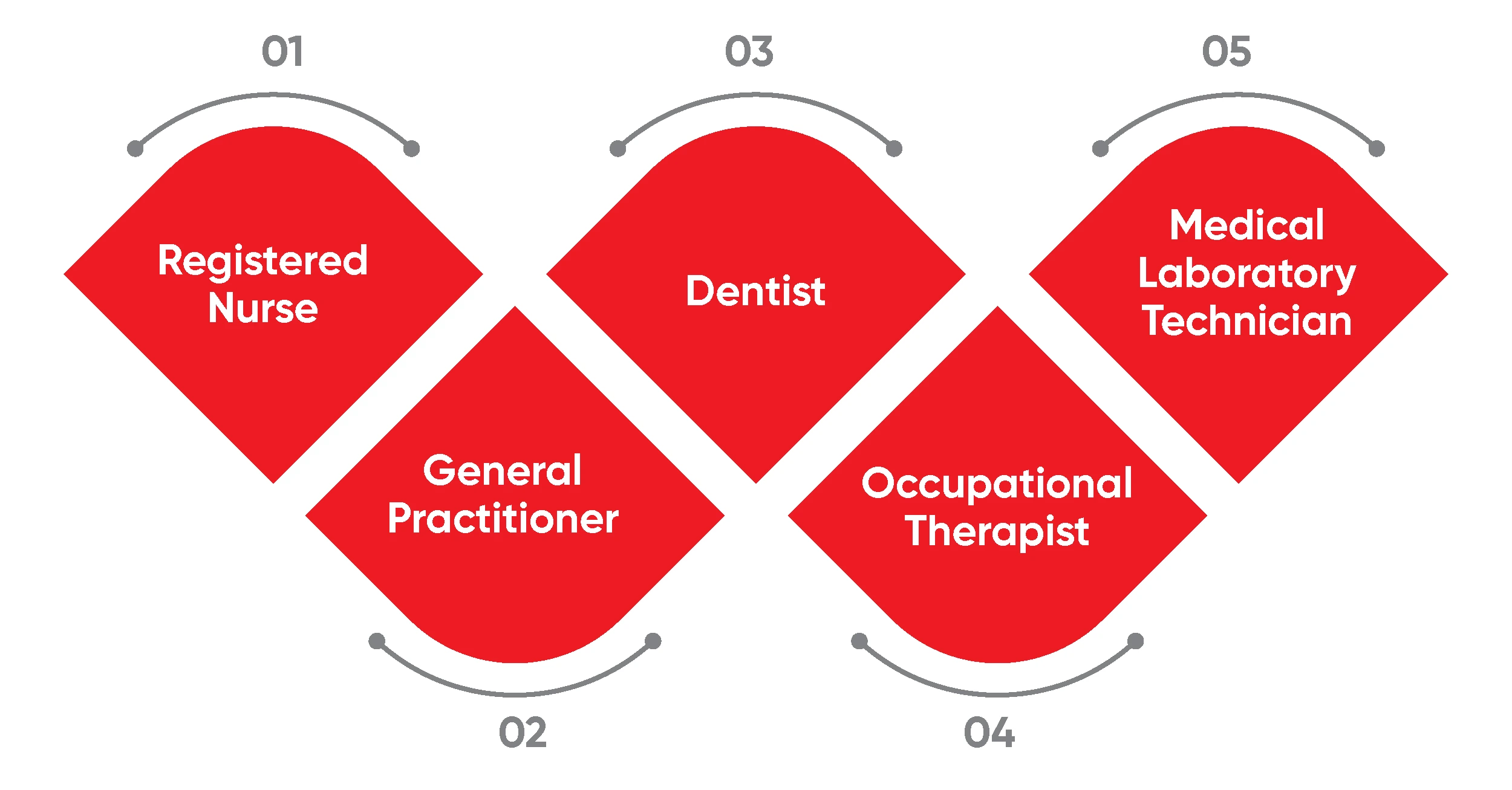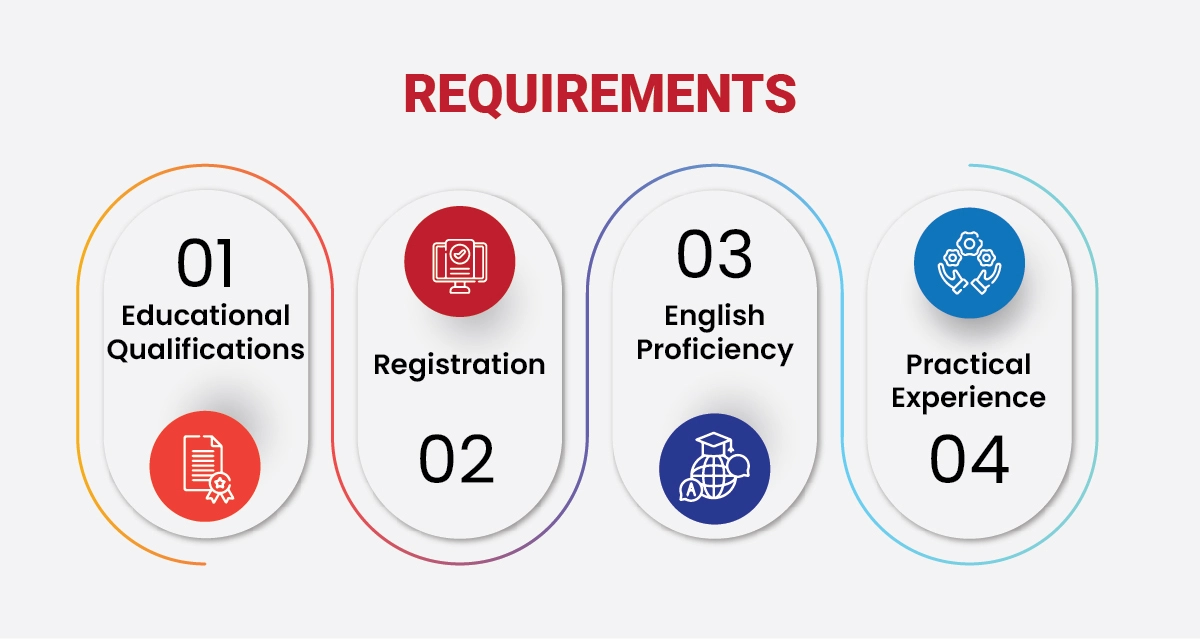Imagine a place where your skills are highly paid, your career flourishes, and your future shines bright, that’s the Australian job market! With booming industries like healthcare, IT, engineering, and finance, the land Down Under is a goldmine for ambitious professionals. Who’s Making the Big Bucks? If you’re wondering which careers are leading the way, we’ve compiled a list of the top 10 highest paying jobs in Australia. Let’s dive in!
Table Of Content
1What are the Highest Paying Jobs in Australia2Top 10 Highest Paying Jobs in Australia3How to Get a Job in Australia4Working Hours in Australia5Job Market in Australia6Frequently Asked Questions
What are the Highest Paying Jobs in Australia
With Australia’s booming economy and high demand for skilled professionals, top earners bring in impressive six-figure salaries. Industries like healthcare, technology, and finance continue to drive wages upward, rewarding expertise and experience. Whether it’s years of study, specialized skills, or leadership roles, the highest paying jobs in Australia offer both financial security and professional prestige. Let’s explore who are the top 10 behind the big paychecks.
- Neurosurgeon
- Anaesthetist
- CEO (Chief Executive Officer)
- Psychiatrist
- Investment Banker
- IT Security Architect
- Mining Engineer
- Software Engineer
- Financial Manager
- Occupational Therapist
Top 10 Highest Paying Jobs in Australia
Without wasting much time, let’s look into the details of each job.

1. Neurosurgeon
A neurosurgeon in Australia diagnoses and treats brain, spine, and nerve conditions through complex surgeries. This highly specialized role requires years of rigorous training and expertise, making it one of the most demanding and prestigious medical careers.
Neurosurgeon Salary in Australia: AUD 600,000+ per year
| Job Code | 253513 |
| Required Qualifications | Medical degree, specialist training in neurosurgery |
| Eligibility Criteria | Positive skill assessment from the AMC, a job offer, state or territory nomination, English language proficiency |
| Top Recruiters | Hospitals and private practices |
2. Anaesthetist
An Anaesthetist in Australia is the guardian of comfort and safety during surgery, carefully administering anesthesia and monitoring vital signs. Their high salary comes from years of rigorous training, the precision their role demands, and the immense responsibility of keeping patients stable in high-risk procedures, making it one of the highest paying jobs in Australia.
Anaesthetist Salary in Australia: AUD 300,000 – AUD 500,000 per year.
| Job Code | 253211 |
| Required Qualifications | Medical degree specialised in Anaesthesia |
| Eligibility Criteria | Register with MedBA, Medical qualifications verified from AMC |
| Top Recruiters | Public and private hospitals |
3. CEO (Chief Executive Officer)
A CEO in Australia leads a company’s strategy, growth, and operations, making key business decisions. This high-level role demands experience, strong leadership, and strategic vision. Their high salary reflects the immense responsibility, leadership demands, and ability to drive profitability in a competitive market.
CEO Salary in Australia: AUD 250,000 – AUD 500,000 per year
| Job Code | 111111 |
| Required Qualifications | MBA certification |
| Eligibility Criteria | Positive skill assessment from AIM, relevant work experience |
| Top Recruiters | Corporate companies |
4. Psychiatrist
A psychiatrist in Australia specializes in diagnosing and treating mental health conditions using therapy and medication. Their high earnings stem from extensive medical training, the complexity of psychiatric care, and the increasing need for mental health professionals.
Psychiatrist Salary in Australia: Average salary AUD 250,000 – 450,000 per year
| Job Code | 253411 |
| Required Qualifications | A medical degree specialisation in psychiatry |
| Eligibility Criteria | Registration with MedBA |
| Top Recruiters | Hospitals |
5. Investment Banker
An investment banker in Australia facilitates mergers, acquisitions, and capital investments, helping clients maximize financial growth. Their high earnings come from expertise in complex financial markets, high-stakes negotiations, and the ability to generate significant revenue. So, 5th in the highest paying jobs in australia list is investment banker.
Investment Banker Salary in Australia: AUD 150,000 – AUD 400,000 range yearly
| Job Code | 222311 |
| Required Qualifications | A degree in economics, business, or finance, plus a CFA, leads to top positions. |
| Eligibility Criteria | A positive VETASSES skill assessment |
| Top Recruiters | Investment banks |
6. IT Security Architect
An IT security architect in Australia designs and implements cybersecurity frameworks to protect organizations from threats. Their high salary comes from their specialized expertise, growing demand for cybersecurity, and the crucial role they play in safeguarding sensitive data.
IT Security Architect Salary in Australia: AUD 140,000 – AUD 250,000 per year.
| Job Code | Cyber security architect – 262117 |
| Required Qualifications | IT security, computer science degree, and cybersecurity certifications |
| Eligibility Criteria | ACS skill assessment, English language proficiency |
| Top Recruiters | Companies seeking cyber security |
7. Mining Engineer
A mining engineer in Australia designs and oversees safe, efficient methods for extracting minerals and resources. Their high salary is driven by the technical expertise required, the industry’s economic importance, and the challenging working conditions in remote mining sites which makes it as the 7th in highest paying jobs in Australia.
Mining Engineer Salary in Australia: AUD 120,000 – AUD 200,000 per year
| Job Code | 233611 |
| Required Qualifications | A degree in mining engineering, metallurgy, or geology. |
| Eligibility Criteria | ENGINEERS AUSTRALIA Skill assessment, English language proficiency |
| Top Recruiters | BHP |
8. Software Engineer
A software engineer in Australia designs, develops, and maintains computer systems, applications, and digital solutions across various industries. Their high salary reflects the strong demand for tech professionals, the rapid growth of the digital economy, and the specialized skills required in programming and system architecture.
Software engineer Salary in Australia: Average will be AUD 110,000 – AUD 125,000 per year.
| Job Code | 261313 |
| Required Qualifications | Bachelor’s or master’s degree in Computer Science, Software Engineering, or a related field |
| Eligibility Criteria | Skill assessment, English language proficiency, work experience |
| Top Recruiters | Corporate companies |
9. Financial Manager
A financial manager in Australia oversees budgets, investments, and financial planning to ensure business stability and growth. Their high salary is because of their expertise in financial strategy, risk management, and the critical role they play in driving a company’s financial success, which makes it the 1oth in the highest paying jobs in Australia list.
Financial analyst Salary in Australia: The average annual salary is AUD 99,000.
| Job Code | 132211 |
| Required Qualifications | A degree in Economics with majors in finance and accounting |
| Eligibility Criteria | Positive skills assessment from CPA Australia, relevant work experience, and English language proficiency |
| Top Recruiters | Finance companies |
10. Occupational Therapist
An occupational therapist in Australia helps individuals regain independence by improving their physical, cognitive, and emotional abilities. Their salary reflects the specialized skills, hands-on patient care, and growing demand for rehabilitation services in healthcare and community settings.
Occupational Therapist Salary in Australia: The annual average salary ranges from AUD 80,000 – AUD 100,000
| Job Code | 252411 |
| Required Qualifications | Bachelor’s or Master’s degree in occupational therapy |
| Eligibility Criteria | Positive skill assessment from OTC, English language proficiency, work experience |
| Top Recruiters | Hospitals and all types of health centres |
How to get a Job in Australia
A step by step guide for this will make things easy for you. It looks like this:
1. Research the Australian Job Market
Before applying, explore job trends, high-demand industries, and salary expectations. Use job boards like Seek and LinkedIn, review government reports, and network with professionals to gain insights. This research helps you target the right opportunities and improve your chances of success.
2. Create an ATS-friendly Resume
An ATS-friendly resume improves job prospects by using a clear format, standard fonts, and keyword-rich content. Avoid graphics and complex layouts to ensure proper ATS scanning. Use standard headings and highlight relevant skills and achievements to increase visibility and interview chances.
3. Apply for Jobs
Start applying through Australian job websites, portals, and company career pages. You can also reach out to HR firms and recruitment agencies for expert job assistance, though some may charge fees.
4. Apply for a Suitable Visa
This is a crucial step for securing a job in Australia from India. Choose the right visa category based on your goals and start the application process. Keep in mind that eligibility criteria and procedures vary by visa type and individual circumstances. Carefully review the requirements before applying to ensure a smooth process
5. Get your Visa Stamped
Once your visa application is approved, complete the remaining immigration formalities. Meanwhile, explore the highest paying jobs in Australia, such as roles in medicine, law, and technology, to target lucrative career options. After finalizing everything, get your visa stamped, book your flight, pack your bags, and you’re ready to move to Australia!
Working Hours in Australia
Australia’s work culture emphasizes balance and flexibility, with a standard full-time schedule of 38 hours per week, typically from Monday to Friday. However, industries like healthcare, retail, and hospitality may have varying shifts, including weekends and nights. Many companies now embrace hybrid and remote work models, allowing for greater flexibility. Employees are also entitled to overtime pay, penalty rates, and mandated break periods, ensuring fair compensation and well-being. With a strong focus on work-life balance, Australia offers a dynamic and supportive work environment for professionals across various sectors.
Job Market in Australia
Australian Job Market Trends in February 2025
- The unemployment rate remained stable at 4.0%.
- Labor force participation held steady at 67.0%.
- Total employment rose to 14,547,800 workers.
- Employment-to-population ratio slightly declined to 64.2%.
- The underemployment rate stayed unchanged at 5.9%.
- Total monthly hours worked increased to 1,980 million, reflecting strong labor demand.
According to the Australian official website
So, looking at these statistics, we can easily say the Australian job market remains stable and resilient, with low unemployment, steady workforce participation, and rising employment figures. While the underemployment rate has remained consistent, the increase in total working hours reflects strong labor demand. Key industries such as healthcare, technology, and skilled trades continue to drive job growth, offering promising opportunities. However, maintaining a balance between job quality, workforce participation, and economic changes will be crucial for long-term stability and growth.
At the same time, highest paying jobs in Australia continue to attract professionals, with fields like medicine, law, engineering, and technology offering some of the most lucrative salaries. These industries not only provide financial rewards but also contribute significantly to the country’s economic growth.
Frequently Asked Questions
- Research the Australian job market and apply for jobs
- Select suitable visa and meet visa requirements
- Prepare your applications
- Arrive in Australia and join your organization





